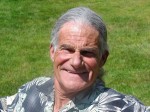The Devil Winds!

The sun is just coming up on an early October morning but you can’t see it through all the soup-like, thick fog down here at St. Ann’s Beach. The steady roar of a strong 5-8 ft. southern hemisphere swell is exploding on the outer reefs, but you can’t see it even from the water’s edge. The air is chilly, about 55 degrees and everything is dripping thanks to the 100% humidity, the dewpoint matching the air temp. at 55 degrees. Paddling out right now is out of the equation at any spot along the entire Orange County coast. Shortly after 9 a.m. the thick gray blanket begins to burn off but it’s still hazy and clammy.
Suddenly at 9:30 a.m. the sky turns a deep blue as a warm offshore breeze can be felt as the dew soaked leaves on the trees evaporates, the dampness is replaced by an air mass from the desert. Air temps. start to soar; in just one hour the thermometer goes from 55 all the way to 82, while humidity levels plummet from 100% all the way down to less than 20%. The breeze soon becomes a steady wind out of the northeast with gusts reaching 30 m.p.h. By noon the air temp. has shot up to 94 degrees as the humidity has sunk to below 10%. Large plumes of spray blow off the tops of the oncoming waves. Yep, you guessed it. The Santa Ana wind season has arrived
Here are the dynamics that create these Santa Ana howlers. After soaking the Pacific Northwest, a cold front plows to the southeast through California, temporarily lowering pressures over the interior causing a thick marine layer to form along the coast. Behind the front, a big strong ridge of high pressure from the Eastern Pacific settles in over Northern Utah with a central pressure of 30.50 inches of mercury. Combining with a weak low over northern Baja, the pressure gradient tightens as the isobars move closer to each other. I should note that winds always blow from a high pressure to its neighboring low pressure. Here in the northern hemisphere, the winds blow clockwise around the high pressure ridge or anticyclone, and winds blow counter-clockwise around a low pressure or cyclone. As a result of this strong pressure gradient, strong northeast winds begin blowing from the Great Basin towards Southern California, heating by compression (3-5 degrees per thousand feet). As they pass over our deserts to funnel through the narrow corridors of our coastal canyons, the resulting hot temps. occur along the coast rather than our desert regions.
More on Santa Anas next time. Aloha!
Dennis McTighe served as a Hickam Air Force Base meteorologist, a NOAA forecaster and earned a degree in earth sciences from UC San Diego. He has been keeping daily weather records since 1958.




